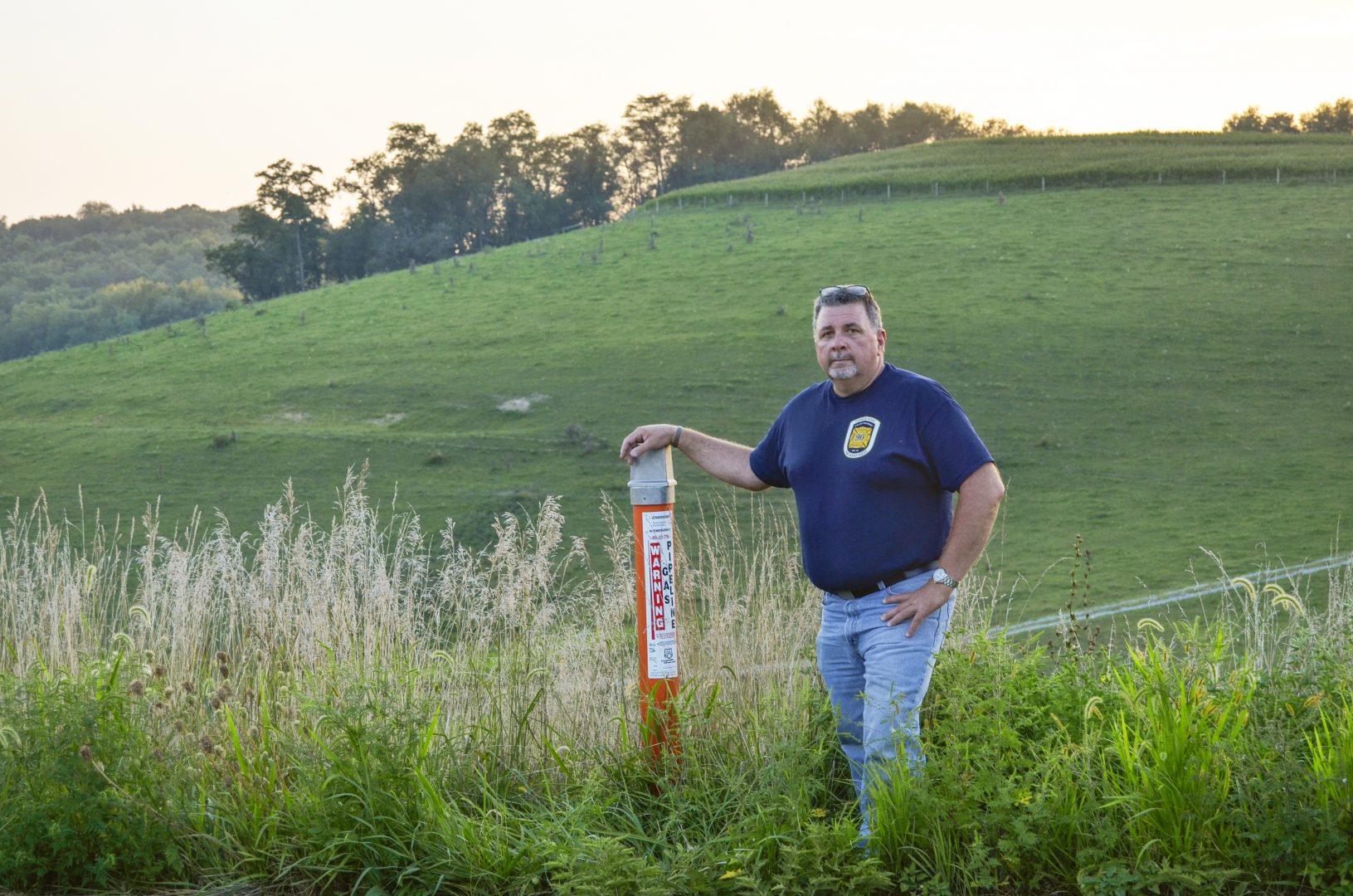
Chief Bob Rosatti of the Forbes Road Volunteer Fire Department stands alongside a marker for the Texas Eastern Transmission Pipeline, which exploded here in Salem Township in 2016.
Amy Sisk / StateImpact Pennsylvania


Chief Bob Rosatti of the Forbes Road Volunteer Fire Department stands alongside a marker for the Texas Eastern Transmission Pipeline, which exploded here in Salem Township in 2016.
Amy Sisk / StateImpact Pennsylvania

Amy Sisk / StateImpact Pennsylvania
Chief Bob Rosatti of the Forbes Road Volunteer Fire Department stands alongside a marker for the Texas Eastern Transmission Pipeline, which exploded here in Salem Township in 2016.
When a major natural gas pipeline leaks, it’s typically the responsibility of the pipeline operator — not the local fire department — to close the valves to stop the flow of gas.
In fact, if the leak catches fire or explodes, firefighters are limited in what they can do to extinguish the blaze. The fire might be so big or hot that they cannot get close enough to try to put it out.
Instead, firefighters’ role during pipeline emergencies is generally to manage the area around the incident. They may spray water on homes and buildings nearby to try to prevent them from catching fire. First responders also evacuate residents and divert traffic away from leaks when they occur.
Pipeline employees can stop the flames by shutting down the flow of gas, either by closing valves remotely or by hand. Firefighters typically lack training on the equipment of specific pipelines and could make a fire worse, for example, if they accidentally turned a valve the wrong way.
However, first responders and pipeline companies almost always coordinate, like during a recent explosion on an Energy Transfer line in Beaver County. Pipeline personnel held meetings to keep first responders updated on developments.
Communication between emergency workers and pipeline operators often starts far earlier, when a company decides to build a pipeline through a community. Many provide training sessions to first responders and invite them to tour their facilities, in addition to other trainings offered by entities like the State Fire Academy.
Among the biggest pipeline project to cross the commonwealth in recent years is Mariner East 2, a line slated to carry natural gas liquids from western Pennsylvania and Ohio to a processing facility and export terminal near Philadelphia.
Energy Transfer, which is building that pipeline in conjunction with a series of other related projects, says more than 2,000 responders have participated in its trainings for its Mariner lines.
The person leading those trainings, Gregory Noll, is a Pennsylvania-based consultant and firefighter. He said he teaches first responders where in the communities the pipeline is located, the basic components of its operation and the physical properties of the substance it’s carrying, such as natural gas or natural gas liquids.
He said his trainings cover the types of incidents that could arise from a problem with a pipeline, as well as how to take a “risk-based response,” which means analyzing the problem and assessing its hazards to determine what course of action to pursue.
Pipeline operators, in conjunction with the State Fire Academy, are developing a pilot project they hope to launch in 2019 to streamline trainings. Modeled after efforts in other states, it’s known as the Pipeline Emergency Responders Initiative.
StateImpact Pennsylvania is a collaboration among WITF, WHYY, and the Allegheny Front. Reporters Reid Frazier, Rachel McDevitt and Susan Phillips cover the commonwealth’s energy economy. Read their reports on this site, and hear them on public radio stations across Pennsylvania.
(listed by story count)
StateImpact Pennsylvania is a collaboration among WITF, WHYY, and the Allegheny Front. Reporters Reid Frazier, Rachel McDevitt and Susan Phillips cover the commonwealth’s energy economy. Read their reports on this site, and hear them on public radio stations across Pennsylvania.
Climate Solutions, a collaboration of news organizations, educational institutions and a theater company, uses engagement, education and storytelling to help central Pennsylvanians toward climate change literacy, resilience and adaptation. Our work will amplify how people are finding solutions to the challenges presented by a warming world.